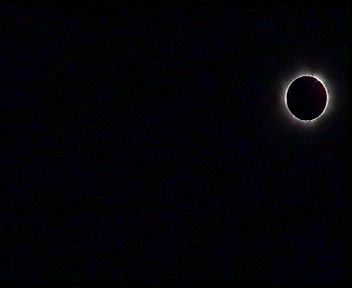 Jupiter is the bright
circle in this picture. Despite the planet being vastly overexposed, two of its galilean moons are clearly visible.
Jupiter is the bright
circle in this picture. Despite the planet being vastly overexposed, two of its galilean moons are clearly visible.These are attempts at capturing astronomical objects with a normal Sony videocamera. I shot the video in the summer of 1999 from the backyard of a country house, with moderate light pollution. I did not have a telescope at the time and the camera was mounted on a standard photographic tripod, so it was not easy to find the objects in the sky... I spent a lot of time just to find M31!
All the images have been grabbed from a single video frame, with no enhancements.
 Jupiter is the bright
circle in this picture. Despite the planet being vastly overexposed, two of its galilean moons are clearly visible. Jupiter is the bright
circle in this picture. Despite the planet being vastly overexposed, two of its galilean moons are clearly visible. |
 The faint fuzzy cloud
in the center is the Andromeda galaxy, also known as M31 (the 31st object in the Messier catalog). This 4.8 magnitude
object is easily seen with binoculars or small telescopes, and possibly with the naked eye if the sky is dark enough. The faint fuzzy cloud
in the center is the Andromeda galaxy, also known as M31 (the 31st object in the Messier catalog). This 4.8 magnitude
object is easily seen with binoculars or small telescopes, and possibly with the naked eye if the sky is dark enough. |
 The Pleiades is an
open clusted in the constellation of Taurus. They were also classified by Messier with number 45, which is a bit
strange because the main purpose of the catalog was to avoid objects that looked like comets, and the Pleiades
are quite easy to tell apart. The Pleiades is an
open clusted in the constellation of Taurus. They were also classified by Messier with number 45, which is a bit
strange because the main purpose of the catalog was to avoid objects that looked like comets, and the Pleiades
are quite easy to tell apart.This is a very beautiful object to look at with the naked eye, and is definitely gorgeous with binoculars or a small telescope at low magnification. Many of the stars in the Pleiades have been given a name, click here for a map that includes star names. |
 The total solar
eclipse in the summer of 1999 was a memorable event. We left from Rome the day before and eventually arrived in
a good place in Hungary with only half an hour left to the beginning of the totality phase. I messed up with the
camera setup so it tilted and fell off during the eclipse. I wasted precious seconds to try and fix it but
eventually decided that a total eclipse is something that first of all must be seen with the eye. So the video
sucks, but I am happy nonetheless for a magnificent show and a remarkable experience. The total solar
eclipse in the summer of 1999 was a memorable event. We left from Rome the day before and eventually arrived in
a good place in Hungary with only half an hour left to the beginning of the totality phase. I messed up with the
camera setup so it tilted and fell off during the eclipse. I wasted precious seconds to try and fix it but
eventually decided that a total eclipse is something that first of all must be seen with the eye. So the video
sucks, but I am happy nonetheless for a magnificent show and a remarkable experience. |
Copyright (c) 2003,2004 Alessandro Scotti. All rights reserved.
| Home :: Amateur Astronomy |